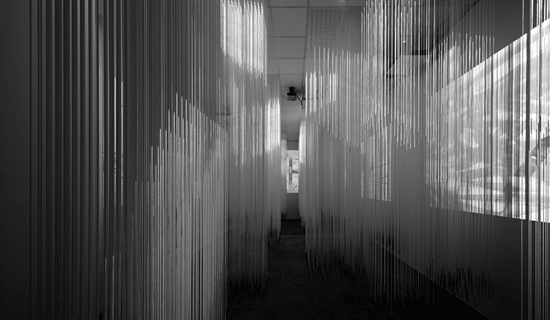Jonas Dahlberg is one of Sweden’s most prominent artists, working at
the intersection of art, architecture and film.
http://www.jonasdahlberg.com

School Corridor, 1986
2010. Kinetic sculpture. Aluminium, steel, LED lamps, motor. Dimensions 135 x ø92.5cm
This work is something between a sculpture and a
mechanical film. I’ve constructed a series of small, three-dimensional
“film frames” creating a horizontal wheel, recalling a film reel. When
the wheel rotates, the rooms are fed forward like a film in a projector,
creating an animation. The rooms are constructed with imperfections and
scratches so that the feeling of early animation mechanisms and early
cinema comes to mind.
In the work I’m addressing an idea of how memories
and film-animations have a connection to each other by the way they are
similarly constructed. To be able to create an animation and an
illuminated frame—or in this case a room—it’s necessary to always have a
dark interval before the next frame/room. The illuminated image is then
imprinted on the retina and is linked by the eye's memory to the
ensuing room, creating a continued movement.
 An Imagined City (work in progress)
An Imagined City (work in progress)
This October, Dahlberg
will present
a site-specific work on and around
the old post office in Stockholm. The
piece is an architectural sound and light installation produced
by MAP, Mobile Art Production. During the restoration of the old post office on Nybrogatan 57, Jonas
Dahlberg has transformed the building into an austere, black façade to
use as his backdrop. In daylight, the temporarily blackened building
becomes the archetypal image of contemporary architecture, only to be
transformed into a seemingly black hole at night. When darkness falls, four windows light up and shine their spotlights
down onto the street. The beams are filled with voices that take the
viewer on a journey through cities, places and buildings, in stories
that are based on an archive of memories of cinematic rooms and spaces.
The austere façade, or the black hole, becomes a screen onto which the
audience can project their own memories, thoughts and ideas regarding
architecture and what a city could be.
Since the very beginning of his career, Jonas Dahlberg has worked
with staged situations revolving around the viewer’s movements through
spaces in different fictitious worlds. In
An Imagined City, he
deepens his interest in the mirroring of psychological architecture. To
date, Dahlberg’s preferred medium has been film, but in
An Imagined City, he leaves the medium behind and steps straight onto the street, where the viewer becomes the focus of events.
An Imagined City is a temporary staging of public space, a
kind of theatre where everything is possible. What kind of city do we
want? Which architecture is imaginable in the first place, and what
happens when one temporarily dramatises a quotidian milieu?





